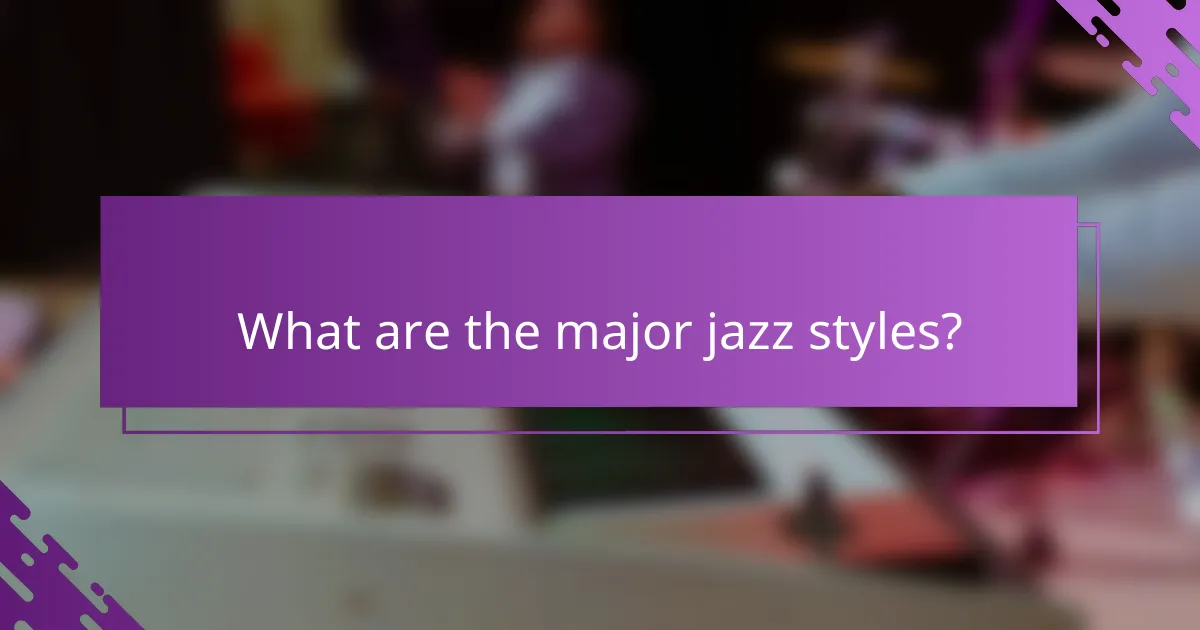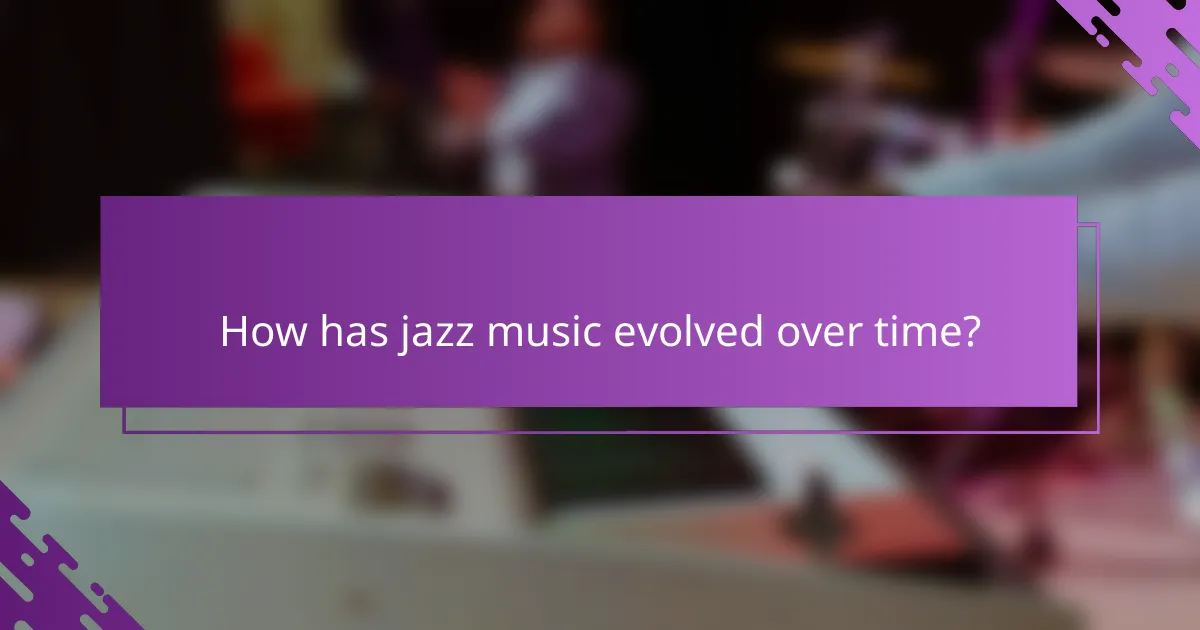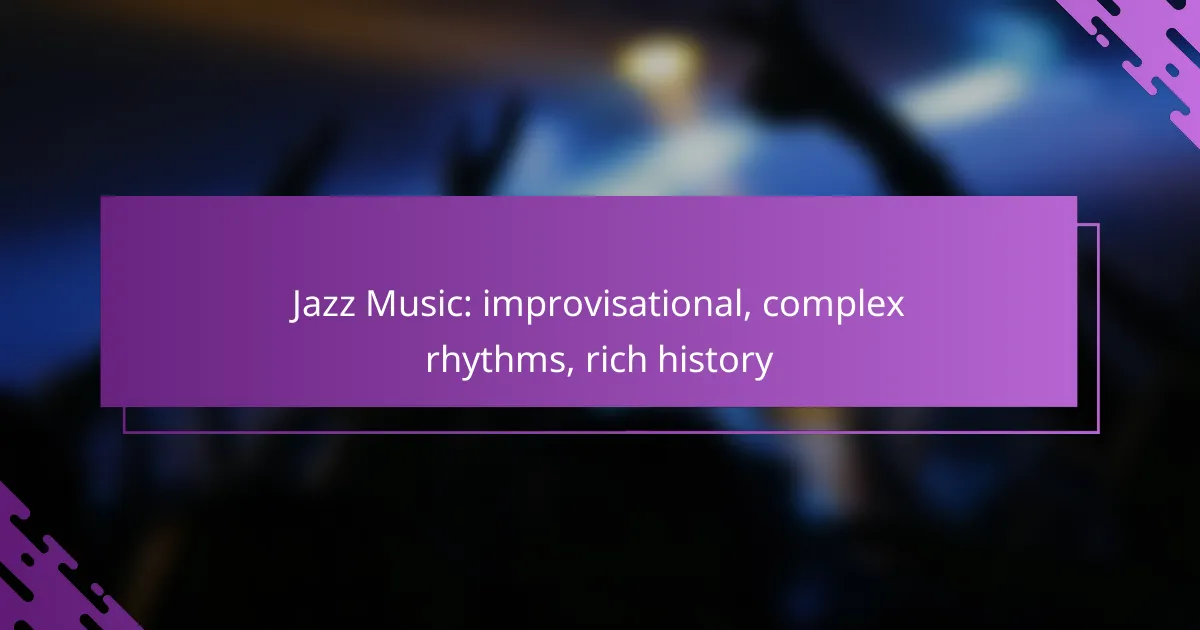Jazz music is a vibrant genre characterized by its improvisational nature, intricate rhythms, and rich harmonic structures. With a history steeped in cultural significance, it allows musicians to express their individuality and creativity through spontaneous performance. Engaging with jazz involves both structured learning and personal exploration, making it a dynamic field for both performers and listeners alike.

How can you learn jazz music effectively?
Learning jazz music effectively involves a combination of structured education, practical experience, and personal exploration. Engaging with various resources such as online courses, private lessons, and workshops can enhance your understanding and skills in this complex genre.
Online courses from Berklee College of Music
Berklee College of Music offers a range of online courses tailored for aspiring jazz musicians. These courses cover essential topics such as jazz theory, improvisation techniques, and ensemble playing, allowing students to learn at their own pace.
Consider enrolling in courses that focus on specific instruments or styles within jazz. Many courses provide video lectures, interactive assignments, and feedback from experienced instructors, which can significantly enhance your learning experience.
Private lessons with local jazz musicians
Taking private lessons with local jazz musicians can provide personalized guidance and immediate feedback. Look for instructors who have a strong background in jazz and can tailor lessons to your skill level and interests.
When selecting a teacher, consider their performance experience and teaching style. Regular practice sessions and one-on-one instruction can help you develop your improvisational skills and understanding of complex rhythms in jazz.
Jazz improvisation workshops
Participating in jazz improvisation workshops is an excellent way to immerse yourself in the genre. These workshops often focus on developing spontaneity and creativity in music-making, which are crucial elements of jazz.
Workshops typically involve group playing, where you can experiment with different improvisational techniques alongside other musicians. This collaborative environment fosters learning and helps you gain confidence in your improvisational abilities.

What are the key characteristics of jazz music?
Jazz music is defined by its improvisational nature, complex rhythms, and rich harmonic structure. These characteristics create a unique sound that allows for personal expression and creativity within the genre.
Improvisational nature
The improvisational nature of jazz is one of its most defining features. Musicians often create spontaneous melodies and solos during performances, allowing for a dynamic and ever-changing experience. This element encourages individual expression and interaction among band members.
Improvisation in jazz can take various forms, from simple melodic embellishments to complex solos. Musicians typically rely on their understanding of scales, chord progressions, and the overall structure of the piece to guide their improvisation.
Complex rhythms and syncopation
Jazz is characterized by its complex rhythms and use of syncopation, which adds a distinctive groove to the music. Syncopation involves placing emphasis on beats that are typically unaccented, creating a sense of surprise and movement. This rhythmic complexity contributes to the genre’s energetic feel.
Musicians often experiment with time signatures and polyrhythms, further enhancing the intricate nature of jazz rhythms. For example, a common practice is to combine 4/4 time with 3/4 or 6/8, resulting in a rich tapestry of sound that keeps listeners engaged.
Rich harmonic structure
The rich harmonic structure of jazz sets it apart from many other musical genres. Jazz often employs extended chords, such as seventh, ninth, and thirteenth chords, which add depth and color to the music. These harmonies create a lush backdrop for improvisation and melodic development.
In addition to complex chords, jazz frequently utilizes modal interchange and chromaticism, allowing for greater harmonic exploration. This flexibility enables musicians to convey a wide range of emotions and atmospheres within their compositions and performances.

Which instruments are commonly used in jazz?
Jazz music features a variety of instruments that contribute to its unique sound, with some being more prominent than others. Commonly used instruments include the saxophone, trumpet, and piano, each playing a vital role in the improvisational and rhythmic complexity of jazz.
Saxophone
The saxophone is a staple in jazz, known for its expressive tone and versatility. It comes in several types, including alto, tenor, and baritone, each offering different ranges and timbres that enhance the music’s emotional depth.
In jazz ensembles, the saxophone often takes the lead in solos, allowing musicians to showcase their improvisational skills. Players can manipulate dynamics and articulation to create distinctive sounds, making it a favorite among jazz artists.
Trumpet
The trumpet is another key instrument in jazz, celebrated for its bright, piercing sound. It is commonly used for both melody and improvisation, allowing musicians to convey a wide range of emotions through its powerful notes.
Jazz trumpeters often utilize techniques such as bending notes and using mutes to alter their sound. This flexibility makes the trumpet an essential component in many jazz styles, from bebop to big band.
Piano
The piano serves as both a harmonic and rhythmic foundation in jazz music. It provides chords and melodies while also allowing for intricate improvisation, making it a versatile instrument in ensembles and solo performances alike.
Pianists in jazz often employ techniques like stride and comping to create a rich texture. The instrument’s ability to play multiple notes simultaneously enables it to support other instruments while also standing out during solos.

What are the major jazz styles?
The major jazz styles include Be-bop, Cool jazz, and Free jazz, each characterized by distinct rhythms, improvisational techniques, and cultural influences. Understanding these styles provides insight into the evolution of jazz music and its rich history.
Be-bop
Be-bop emerged in the 1940s as a reaction against the commercialized swing music of the time. It is known for its fast tempos, complex chord progressions, and intricate melodies, often featuring extended harmonies and syncopated rhythms.
Key figures in Be-bop include Charlie Parker and Dizzy Gillespie, who pushed the boundaries of improvisation. Musicians typically perform in small groups, allowing for greater interaction and spontaneity during performances.
Cool jazz
Cool jazz developed in the late 1940s and early 1950s, emphasizing a more relaxed tempo and smoother sound compared to Be-bop. This style incorporates elements of classical music and often features softer dynamics and intricate arrangements.
Notable artists like Miles Davis and Chet Baker exemplified cool jazz with their lyrical improvisation and sophisticated harmonies. The use of unusual instruments, such as the French horn or flute, is also common in this genre, adding to its unique texture.
Free jazz
Free jazz emerged in the 1960s, breaking away from traditional structures and conventions of jazz music. This style is characterized by its emphasis on improvisation without predetermined chord progressions or time signatures, allowing musicians to explore sound and expression freely.
Pioneers like Ornette Coleman and John Coltrane challenged listeners with their avant-garde approaches, often creating a chaotic yet expressive musical experience. Free jazz encourages individual expression, making it a platform for experimentation and innovation within the genre.

How has jazz music evolved over time?
Jazz music has evolved significantly since its inception in the early 20th century, influenced by various musical styles and cultural movements. Key developments include the incorporation of blues and ragtime elements, the integration of electronic instruments, and the emergence of global fusion trends that reflect diverse musical traditions.
Influence of blues and ragtime
The roots of jazz can be traced back to blues and ragtime, which provided essential rhythmic and melodic foundations. Blues introduced expressive, soulful elements and a call-and-response structure, while ragtime contributed syncopated rhythms and a piano-centric style. Together, these genres shaped the improvisational nature of jazz.
As jazz progressed, musicians began to blend these influences, leading to the development of styles such as New Orleans jazz, characterized by collective improvisation and a lively ensemble sound. This fusion allowed jazz to evolve into a more complex and dynamic genre.
Integration of electronic elements
In the mid-20th century, jazz musicians began incorporating electronic instruments, which transformed the genre significantly. Instruments like electric guitars, synthesizers, and electronic keyboards added new textures and sounds, allowing for innovative compositions and performances. This shift gave rise to subgenres such as jazz fusion, which combined jazz with rock and funk elements.
Artists like Miles Davis and Herbie Hancock were pioneers in this movement, experimenting with technology to expand the boundaries of jazz. The integration of electronic elements has continued to influence contemporary jazz, making it more accessible and diverse.
Global jazz fusion trends
Jazz has transcended its American origins, leading to a rich tapestry of global fusion trends. Musicians from various cultures have blended their traditional music with jazz, resulting in unique styles such as Afro-Cuban jazz, Indian jazz, and European jazz. These fusions often incorporate local instruments, rhythms, and scales, enriching the jazz landscape.
For instance, the use of traditional African rhythms in jazz has created a vibrant dialogue between cultures, showcasing the genre’s adaptability. This global exchange not only broadens the appeal of jazz but also fosters collaboration among artists worldwide, further evolving the genre.

What are the best jazz festivals in the United States?
The best jazz festivals in the United States showcase a blend of legendary artists and emerging talent, offering diverse experiences for music lovers. Key festivals include the Newport Jazz Festival, which is renowned for its historic significance, and others that highlight the rich cultural tapestry of jazz music.
Newport Jazz Festival
The Newport Jazz Festival, held annually in Newport, Rhode Island, is one of the oldest and most prestigious jazz festivals in the world. Established in 1954, it features a mix of established jazz legends and contemporary artists, drawing thousands of attendees each summer.
Visitors can enjoy performances across multiple stages set against the scenic backdrop of Fort Adams State Park. It’s advisable to purchase tickets early, as they often sell out quickly, and consider attending workshops or panel discussions for a deeper understanding of jazz.
Montreux Jazz Festival
Although primarily held in Switzerland, the Montreux Jazz Festival has significant ties to the U.S. jazz scene, often featuring American artists. This festival takes place every July along the shores of Lake Geneva and is known for its eclectic lineup that includes not just jazz, but also rock, blues, and soul.
Attendees can expect a vibrant atmosphere with numerous performances, jam sessions, and food stalls. Planning ahead is crucial, as accommodations in Montreux can be expensive and fill up quickly during the festival period.
North Sea Jazz Festival
The North Sea Jazz Festival, held in Rotterdam, Netherlands, is another major event that attracts a global audience, including many from the U.S. This festival typically occurs in July and features a wide range of jazz styles, from traditional to contemporary, as well as fusion genres.
With hundreds of performances across multiple venues, attendees can explore various artists and styles. It’s recommended to check the lineup in advance and consider purchasing a multi-day pass for the best experience, as this festival is known for its extensive program and vibrant atmosphere.
